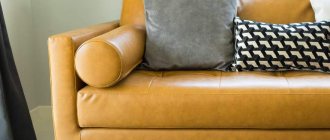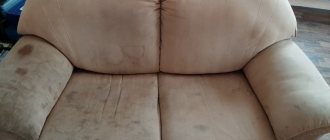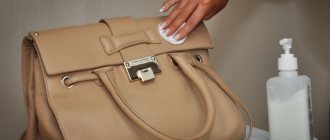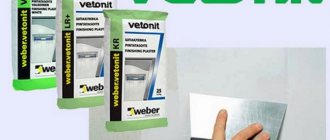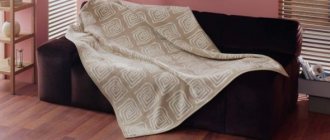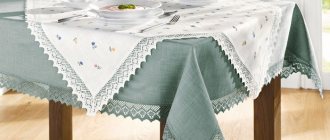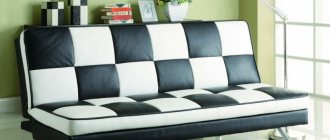During operation, abrasions, cracks, stains and snags may occur, which sooner or later will lead to the formation of bald spots and holes requiring expensive repairs.
If you think the only way to prevent this is to use protective covers. Then what is the point of spending money on such furniture, the beauty of which will always be hidden under the mask of bedspreads?
There are other ways to care for eco-leather furniture that will preserve its original appearance after many years of daily use.
A few important rules
Before buying eco-leather furniture, first of all think about practicality. The purchase will not be beneficial if:
- There are animals in the house that like to sharpen their claws on the end of the wooden frame.
- There are small children who love to draw with felt-tip pens.
- There is a lot of traffic in the room during the day.
All this will lead to the fact that the furniture will be constantly exposed to negative influences and will quickly lose its attractive appearance. Therefore, if you have a sofa or chairs made of this material in your home, remember a few important rules:
- Any dirt must be removed immediately using a soft damp cloth or rag - eco-leather is difficult to clean from old dirt, as the surface can easily be damaged, leaving scratches.
- Furniture needs daily preventive cleaning - small debris accumulates in the joints and depressions, which will stick to clothes in a couple of days.
- If the stain is old and dried, then you need to apply a damp soft cloth to it for 2-3 hours, waiting until it softens and moves away from the surface on its own without applying force.
- It is better to install eco-leather furniture away from radiators and radiators, since they dry out the air, which will cause cracking of the coating if it is not treated with special moisturizing mixtures.
- If there are animals in the house, then they should be weaned from sharpening their claws on the sofa. There are special products that emit an unpleasant odor, scaring the animal away from the furniture.
- Before using a cleaning product, be sure to check whether it is suitable for eco-leather. Typically, the furniture manufacturer gives recommendations regarding care, indicating specific brands of detergents and cleaning products.
By following these rules, eco-leather furniture will last for many years, and it will look the same as after purchase.
Professional preparations
Eco-leather is a relatively new fabric that has recently appeared on the market. It is a high-tech material produced without the use of PVC.
This is an artificial fabric, for cleaning which professional products suitable for leatherette or leather products are used.
What to clean with? From professional chemicals, it is recommended to use such cleaning products as Vineet, Pufas Glutoclean, Turtle Interior, Runway, Fill In.
They serve as a kind of dry cleaning for furniture and other eco-leather products. Their peculiarity is the effective removal of contaminants and the absence of damage after use.
How to wash stains and how:
- Vinette for interior dry cleaning is the best that is currently on sale on the market. The concentrated product is diluted before use, otherwise the eco-leather can be burned. After cleaning, the material is immediately treated with conditioner. If used in concentrated form, white spots will appear and the item will lose color.
- Pufas Glutoclean is designed for cleaning natural leather, but is also suitable for this material. It does not dry out and refreshes the surface. It can be used to remove any type of contaminant.
All professional chemicals can harm the material. It should be used strictly according to the instructions.
How not to clean?
It’s paradoxical, but even the highest quality material can be ruined due to ignorance. To prevent this from happening, pay attention to the following points:
- Do not use hard brushes to remove difficult stains. Abrasives will scratch the surface, which will later create a hole.
- Avoid using gasoline, solvents and other aggressive compounds that can leave burn marks.
- Do not use hot air from a hair dryer for drying. It deforms eco-leather and makes it vulnerable at the slightest tension.
- Coarse cleaning powders, as well as salt and soda, scratch it upon contact with the surface, so you should also avoid using them in cleaning.
- It is strictly forbidden to use bleach and other chlorine-containing products, as they destroy the structure of eco-leather and bleach the color. In addition, the material is capable of accumulating an unpleasant and pungent odor that lasts for several days.
- Acetone and products containing it cannot be used to remove any types of stains.
Some “traditional craftsmen” advise using alcohol if there are persistent stains. This should not be done, since alcohol in its pure form can leave a burn at the site of application, which will soon cause the formation of cracks and holes.
Advantages and disadvantages of eco-leather products
This material has hypoallergenic properties, so it is suitable even for those who have similar problems. The eco-leather structure allows air to pass through well. Main advantages of the products:
- accessibility of the price segment;
- similarity to natural leather;
- long service life;
- pleasant tactile sensations: softness, warmth;
- the material does not emit foreign odors or harmful substances.
Thanks to the unique structure of leatherette, different designs and colors of the canvas are possible. This is a worthy analogue of the natural option, safe and easy to maintain.
The material has fewer negative aspects; they are more related to improper care of the products. In addition, eco-leather can crack at folds and be scratched from the use of abrasive cleaning agents.
In most cases, your sofa can always be saved and protected from dirt.
Daily care
It is recommended to clean furniture once a day. No special detergents are needed for this.
You can do this in two ways:
- Dry cleaning with a sofa vacuum cleaner - be sure to use a soft attachment on the vacuum cleaner that will not scratch the surface. Cleaning will help remove all the dust and dirt, as well as crumbs and small dirt.
- Wet cleaning - a soft rag is moistened in warm water, completely wrung out and passed over the surface of the furniture. First, dirt is removed from the folds, after which the entire surface is wiped.
There is no need to apply any products, nor do you need to dry it. The furniture will dry on its own in 1 hour.
There are special microfiber cloths that have long pile and remove dirt well without having a negative impact on eco-leather.
Drink Stains
At home, it is quite possible to wash traces of drinks from a white sofa. The main thing is to act quickly so that the liquids do not have time to be absorbed.
- Use a dry cloth or napkins to collect any remaining spills from the surface. If you don't have paper towels or a rag on hand, you can sprinkle salt, then collect it along with the absorbed drink.
- Wipe the stained area with hydrogen peroxide, an aqueous solution of vinegar or citric acid, if the pigment remains. The proportions of 9% vinegar to water are the same as when using acid: one to one.
- After treatment, wash the leatherette with soapy water or wipe with damp cloths, dry the surface with towels.
Fighting stains
No matter how carefully you care for your furniture, stains will appear sooner or later.
Greasy and corrosive, they spoil the appearance of any, even the most expensive furniture, and the removal of each of them has its own characteristics.
Oily stains
The faster the fat is removed from the surface of the eco-leather sofa, the easier it will be to remove the stain.
The sequence of actions is as follows:
- Quickly remove excess grease with a dry cloth without pressing on its surface, as the stain will penetrate deeper into the coating faster. Change the napkins until they no longer absorb grease particles.
- Take a drop of dish detergent, apply evenly to the stain, and leave for 3-4 minutes.
- Use a damp soft cloth to remove any remaining detergent in a circular motion.
- Let it dry.
If you are unable to remove the stain the first time, you can try this method several more times. The contamination will become noticeably lighter, after which it will be completely unnoticeable.
In the event that a greasy stain was created a long time ago, but was not noticed immediately, the following improvised means will help:
- Ammonia and warm water - take 1 tablespoon of ammonia per glass of warm water, dilute it, blot a rag and apply it to the stain. Press down lightly and hold for 3-5 minutes.
- Hydrogen peroxide – take a cotton pad, soak it well in peroxide and place it on the stain. Cover with a rag and place a light weight (book, overturned chair). After 5 minutes, remove the cotton pad and let the stain dry.
- Shaving foam - apply a thick layer of foam, leave for 5 minutes, then remove any remaining residue. There is no need to wash it off.
If all this does not give the desired result, then you can buy a special stain remover for eco-leather furniture. The instructions will indicate how and in what cases to use it.
Contamination from markers and pens
Traces from a ballpoint pen are among the most difficult types of stains to remove, which hopelessly stain eco-leather furniture. It is not always possible to completely remove contamination, and old stains will remain in place forever.
If this type of contamination occurs, you can try the following methods:
- Hair fixing varnish - spray varnish onto the ink stain, wait 2-3 minutes, remove the residue with a cotton pad. Repeat until all dirt is gone.
- Slaked soda works well with markers and felt-tip pens. Extinguish a tablespoon of baking soda with a tablespoon of apple cider vinegar, apply the paste to the stain, and after a minute wipe off the residue.
- Nail polish remover - lightly wet a cotton pad and clean it with gentle, gentle movements in the direction of the stain.
- Glass cleaner - apply to the stain, let sit for 5 minutes, then use gentle blotting movements to remove any remaining dirt.
The faster the action was taken, the greater the chance of completely getting rid of the ink and felt-tip pen stain.
Wine and juice stains
If an alcoholic drink, juice or compote gets on the surface of light-colored furniture, there is every chance that a colored stain will remain. It’s not easy to fight it, but you can try the following methods:
- Liquid soap and citric acid - dissolve ¼ teaspoon of citric acid in 50 ml of water, add a tablespoon of any liquid soap. Apply the resulting mixture to the stain and gently wipe it off with gentle movements.
- Dishwashing detergent and ammonia - take 1 drop of ammonia for 1 tablespoon of dishwashing detergent, apply to the stain, let stand for 10 minutes, then remove the excess.
Spilled drinks must be removed from the surface as quickly as possible before they are absorbed by the coating. The older and deeper the stain, the more difficult it is to deal with.
How to clean leatherette from household dirt?
- Before you start cleaning the sofa, you need to prepare the required cleaning products so that you have access to them at any time;
- It is necessary to cover with film the area in which the sofa will be cleaned, or remove the carpets on the floor;
- The light should be evenly distributed over the entire surface to be cleaned;
- Emergency drying of the product through direct sunlight and radiators is not allowed;
- The use of products containing chlorine, acetone, 100% alcohol, and chemicals should be avoided;
- To avoid damaging the integrity of the fabric, do not use brushes with hard bristles or sharp objects.
- fabric napkins, sponges: melamine, soft;
- wet wipes for leather/leatherette products;
- ammonia;
- hydrogen peroxide;
- vodka;
- nail polish remover;
- lemon juice;
- colorless cream;
- stain removers for special purpose leatherette;
- Polish for hair;
- glass washing liquid;
- “Vinet” is a dry cleaning product.
- dissolve ammonia in water;
- soak a sponge in the mixture;
- treat the stain.
- Spray the rag or the dirt itself with varnish;
- wipe;
- If there is no result, perform the manipulation again.
- dip a rag in the substance;
- rub the stain until it is completely removed;
- soak the sponge in a diluted soap solution;
- treat the cleaned area with soap foam;
- rinse with water;
- dry.
- chocolate stains can be quickly and effortlessly removed with glycerin soap;
- bitumen and resin stains are removed from leatherette using a sponge moistened with ethyl alcohol (90%) or turpentine oil;
- stains left by red wine or drinks are removed with a sponge soaked in diluted vinegar or soap suds;
- children's drawings with a marker on furniture can be removed with a melamine sponge: rub the stain until it disappears completely;
- Grass and grease stains are eliminated with natural lemon juice, which also provides the leatherette with shine.
Eco-leather, like many synthetic materials, does not like moisture too much. For this reason, items made from this fabric should be washed only in extreme cases, and if there is minor dirt, simply clean it.
To do this, it is recommended to use special products that are easy to find in household chemical stores and act in accordance with the attached instructions. But if it was not possible to purchase the composition, it is permissible to use available materials.
You can remove street dust, dirt and stains from the surface using simple means:
- toilet and laundry soap;
- ammonia;
- shaving foam;
- lemon;
- hydrogen peroxide (only for light-colored eco-leather).
Any of the selected products will cope with minor stains no worse than a special composition. To do this, just dissolve it in water and apply it to the surface, then wipe the material with a damp sponge. If we are talking about local cleaning, when it is necessary to remove a stain, it is permissible to use the listed products in their pure form.
Disinfection
Any surfaces in the house need periodic disinfection, which will help reduce the concentration of pathogenic microorganisms. And the eco-leather sofa is no exception. The following means can be used for this purpose.
| Name | Frequency | Sequencing |
| Baby liquid soap | 1 time per month | Dissolve a teaspoon of soap in a glass of warm water until it foams. Moisten a soft cloth in soapy water, twist it well and walk over the entire surface. The cloth should be rinsed periodically in soapy water. |
| Water with lemon juice | Once every 2-3 months | For 1 liter of warm water you need to take 3 tablespoons of lemon juice. First, you should treat the armrests and headrests where there are visible areas of grease. Next, use a damp cloth to go over the remaining areas. |
| Water with ammonia | Once every 6 months as a preventive measure | You need to dissolve 4 tablespoons of ammonia in 1 liter of warm water, moisten a soft rag and walk over the entire sofa. If there are stains, you can linger on them and treat them several times |
| Special antibacterial wipes for leather furniture | Daily or as needed | Take the napkin out of the pack, unfold it and apply it to the recommended area. If there is a lot of furniture, then you need to use more than one napkin, but change them as they become dirty. |
Disinfection should be carried out as soon as it gets dirty. If the furniture is rarely used, then once a month is enough. With high traffic, treatment is needed daily.
What types of leatherette are there?
Leatherette is an artificial material that imitates leather. If the product is manufactured in accordance with all standards, then its quality is not lower than natural. There are several types of this material:
- Vinilis, or vinyl. It is not recommended to buy furniture made from this material for your home, because... it may emit harmful fumes. For this reason, such sofas are installed in office premises.
- Modified leather. The material is based on leather scraps.
- Polyurethane or eco-leather. Does not cause harm to health. To improve the quality of the product, some manufacturers additionally make a top layer of Teflon film.
Eco-leather is also divided into several types:
- Oregon;
- alba;
- dollaro;
- companion.
The best care products
Manufacturers of high-quality eco-leather furniture insist that owners use only specially developed products that do not harm the coating, remove dirt well and protect the surface from cracking. The best of them are the following:
- Eco mist is a spray that does not require rinsing. It removes dirt well, is non-toxic, completely safe for children and pets. Gives furniture shine and gloss. Does not contain fragrances and is safe for allergy sufferers and asthmatics.
- Glutoclean – removes dirt and debris well and has an antistatic effect. Does not cause allergic reactions, protects leatherette from the negative effects of ultraviolet radiation and dry air.
- Unicum – gently cleanses and nourishes eco-leather, gives a beautiful, moderate shine. Does not require rinsing or wearing gloves.
Before using products, make sure that they are specifically approved for use on non-natural leather surfaces. Read the instructions first, as each of them has its own method of application, and some need to be rinsed off.
Rules for removing stains
Paradoxically, furniture and things made of white leatherette have advantages over colored ones, because when scrubbing their surface, there is no risk of washing off the dye and getting a lightened stain.
7 simple truths about stain removal:
- It is easier to remove fresh stains.
- All stain removers must first be tested on an inconspicuous area of the product.
- Do not scrape off dirt or use abrasives.
- It is necessary to erase traces of brush, paints, and brilliant green, moving from the edges to the center.
- When removing a stain, you need to change the cotton pads more often so as not to smear the dirt.
- Cotton balls should be proportionate to the size of the stain. It is better to remove some stains with cotton swabs - this will reduce the area of treatment, and therefore the risk of rubbing off pigmentation and damaging the surface.
- Eco-leather conditioner will help protect a white sofa, armchair, and chair upholstery - it must be applied after each wash. The silicone film on the surface will prevent the absorption of dirt.
When purchasing items made from leatherette, it is advisable to ask the seller about the type and composition of the material, and also to keep the flap that the manufacturer attaches to the label of the product or furniture. On this piece you can test the effect of stain removers, if necessary.
General tips and tricks
Caring for eco-leather furniture, although not easy, is worth it. The coating will have an attractive appearance that cannot be distinguished from real leather.
Follow these guidelines:
- Do not cut off the dirt with a sharp object - this may lead to the formation of a hole.
- Aggressive chemicals, even in small quantities, are prohibited.
- It is better not to use a hairdryer and ice cubes - temperature changes will lead to damage to the integrity of the canvas.
- If a stain appears, you need to remove it as quickly as possible before it gets stuck.
Expert opinion
Kokovin Dmitry Vasilievich
Furniture restorer
Furniture made from eco-leather in light colors is more whimsical, since over time it can darken and fade, and any dirt is clearly visible. Think before you make a purchase and evaluate its feasibility specifically for your home.
Wash
Is it possible to wash eco-leather in a washing machine? To find out whether clothing can be subjected to such a procedure, you should read the information on the label. The label indicates the mode, temperature and how to wash eco-leather by hand or in a machine.
How to wash eco-leather in a washing machine:
- Turn the clothes inside out. Place the equipment in the drum.
- Pour detergent into the dispenser; it should not contain chlorine.
- Eco-leather items should be washed at a temperature of no more than 30 degrees.
- The cycle is delicate or manual.
- Do not dry or tumble dry.
If you cannot wash your clothes using modern technology, soak them briefly in a soapy solution. Rub gently, squeeze out the water lightly and hang on a hanger to dry.

